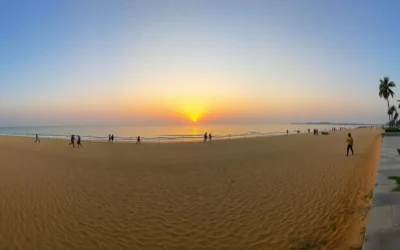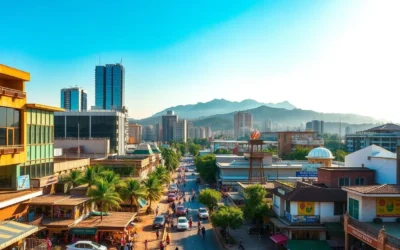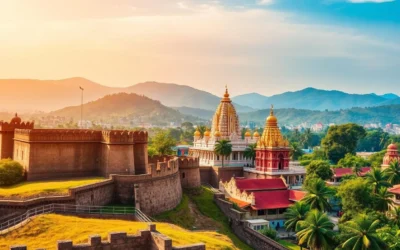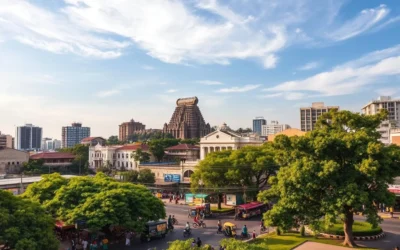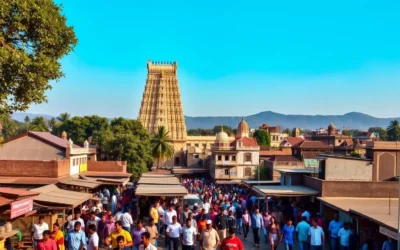✓ Accommodations ✓ Flights ✓ Rental Cars ✓ Tours & Activities
Planning a trip to Tamil Nadu requires more than just choosing a destination; it demands understanding the region’s diverse climate and weather patterns.
The southern Indian state experiences three distinct seasons: winter, summer, and monsoon, each significantly impacting your travel experience.
Understanding these seasonal variations is crucial for a weather-savvy trip, allowing you to align your travel goals with the most suitable weather conditions, whether you’re interested in cultural exploration, outdoor adventures, or relaxing beach time.
This guide will help you navigate South India’s unique climate zones and make informed decisions about the best time to visit.
Understanding Tamil Nadu’s Unique Climate
Understanding the climate of Tamil Nadu requires a look into its unique geographical features and their impact on weather patterns. Tamil Nadu, situated on India’s southeastern coast, experiences a climate that is distinct from the rest of the country.
Geographic Influence on Weather Patterns
The geographic position of Tamil Nadu, coupled with the Eastern Ghats mountain range and the Bay of Bengal, significantly influences its climate. The varied geography results in different weather conditions across the state, with coastal areas like Chennai experiencing different conditions than inland cities like Madurai.
| Region | Weather Pattern | Influence |
|---|---|---|
| Coastal Areas | Moderate temperatures, high humidity | Bay of Bengal |
| Inland Cities | Higher temperature variations | Eastern Ghats |
| Hill Stations | Cooler temperatures, significant rainfall | Elevation and monsoon |
The Northeast Monsoon Effect
Tamil Nadu is predominantly affected by the northeast monsoon during November and December, a period characterized by intense rainfall. This monsoon is crucial for the state’s annual rainfall, differing from the southwest monsoon that affects most of India. The onset of the northeast monsoon is marked by intermittent thunderstorms, eventually leading to substantial downpours.

The unique climate of Tamil Nadu, influenced by its geography and the northeast monsoon, has shaped the local culture, architecture, and lifestyle over time. Understanding these seasons is essential for appreciating the region’s diversity.
Tamil Nadu, India: Best Months for a Weather-Savvy Trip
To make the most of your trip to Tamil Nadu, it’s essential to know the ideal months to visit. The state’s diverse climate means that the best time to visit can vary significantly depending on what you’re looking for.
November to February: The Golden Period
The period from November to February is considered the “golden period” for visiting Tamil Nadu. During these months, the weather is characterized by comfortable temperatures ranging from 20-30°C and minimal rainfall. This makes it an ideal time for exploring both coastal areas and inland attractions without weather disruptions. December and January are particularly pleasant, with a winter climate that’s perfect for sightseeing at Tamil Nadu’s numerous temple complexes and heritage sites. February offers a great balance of warm days and cool evenings, ideal for cultural exploration and outdoor activities.

| Month | Temperature Range (°C) | Rainfall |
|---|---|---|
| November | 22-28 | Minimal |
| December | 20-25 | Low |
| January | 20-25 | Low |
| February | 22-30 | Minimal |
March to May: Pre-Monsoon Opportunities
Visiting Tamil Nadu during the pre-monsoon period (March to May) has its advantages, including fewer tourists and potential cost savings. Although temperatures gradually increase, making early morning and evening explorations a good strategy to avoid the midday heat. To manage the warmer conditions, it’s advisable to stay hydrated and wear appropriate clothing. This period can be a good time for those looking for a more relaxed experience and lower prices.
Tips for Pre-Monsoon Travel: Stay hydrated, wear light and breathable clothing, and plan your activities for early morning or late evening to avoid the peak heat.
Summer in Tamil Nadu: June to September
Summer in Tamil Nadu, spanning from June to September, brings with it a distinct set of weather conditions that travelers should be aware of. The state experiences a significant rise in temperature and humidity during these months.
Heat Patterns and Humidity Levels
Tamil Nadu’s summer is characterized by high temperatures and humidity, especially in low-lying areas. Temperatures often exceed 35°C (95 F), making the heat feel even more oppressive due to the humidity. Coastal cities like Chennai experience a hot and humid climate, where the heat index can make the temperature feel significantly higher than the actual reading.
| City | Average Temperature (°C) | Humidity Level (%) |
|---|---|---|
| Chennai | 36 | 70 |
| Madurai | 38 | 65 |
| Coimbatore | 35 | 60 |
Hill Stations as Summer Retreats
Despite the sweltering heat in the plains, Tamil Nadu’s hill stations offer a cool respite. Places like Ooty, Kodaikanal, and Yelagiri provide temperatures that are 10-15°C cooler than the lowlands. These hill stations are not only cooler but also offer lush landscapes and a range of outdoor activities.
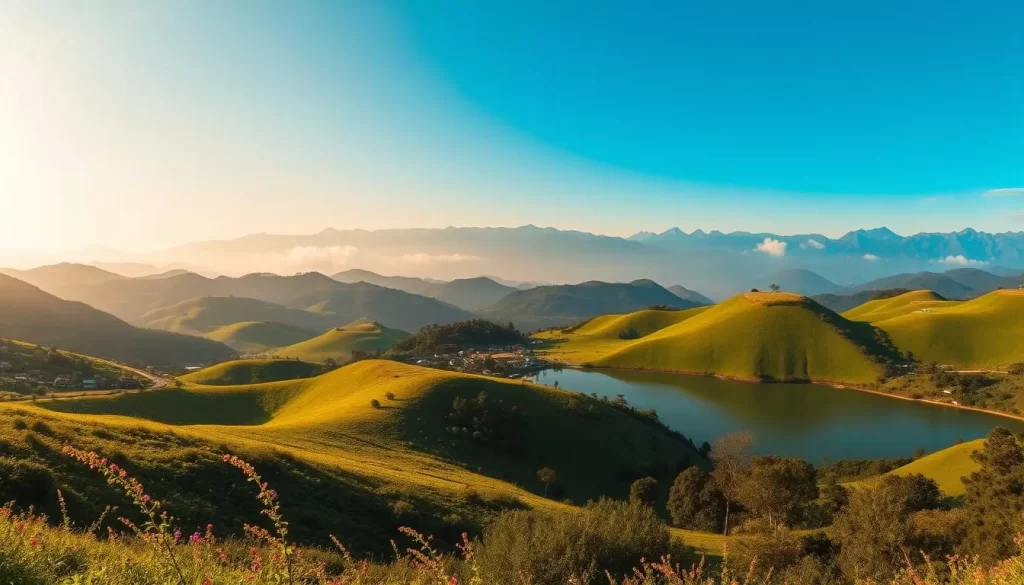
Visiting these hill stations during summer allows you to enjoy pleasant weather and scenic beauty. However, they tend to get crowded during school holidays (May-June), so planning your visit accordingly can help you avoid the peak tourist season.
Monsoon Season: What to Expect
As the southwest monsoon clears out, Tamil Nadu welcomes the northeast monsoon, bringing much-needed rain to the region. This shift in weather patterns is crucial for the state’s agriculture and overall ecosystem.
The Northeast Monsoon
The northeast monsoon, which occurs from October to December, is a significant weather phenomenon in Tamil Nadu. It’s a short but intense monsoon that brings heavy rainfall to the region, particularly affecting the states of Tamil Nadu, Karnataka, and Kerala. During this period, the region experiences heavy bursts of rain followed by pleasant sunshine, providing respite from the heat.
- The northeast monsoon typically occurs from October to December.
- The states of Tamil Nadu, Karnataka, and Kerala receive most of their rainfall from this monsoon.
- The rainfall is characterized by heavy bursts followed by sunshine.
Navigating Rainy Days in Tamil Nadu
When traveling to Tamil Nadu during the monsoon season, it’s essential to be prepared for the rain. You should pack appropriate rain gear, including waterproof clothing and sturdy footwear. Additionally, consider protecting your electronics and valuables from water damage. Some attractions may be inaccessible due to flooding or muddy conditions, so it’s crucial to plan your itinerary accordingly.

- Pack rain gear and waterproof clothing.
- Protect electronics and valuables from water damage.
- Plan your itinerary according to weather conditions.
By being prepared and flexible, you can make the most of your trip to Tamil Nadu during the monsoon season and enjoy the state’s lush, vibrant landscapes.
Cultural Calendar: Timing Your Visit with Festivals
Experience the best of Tamil Nadu’s culture by timing your trip with its numerous festivals and celebrations. The state’s rich cultural calendar offers year-round opportunities to experience authentic local traditions and celebrations that can enhance your travel experience.
Pongal: Tamil Nadu’s Harvest Celebration
Pongal, celebrated in mid-January, is Tamil Nadu’s most important festival, marking the harvest season. This four-day celebration is not only about the traditional Pongal dish but also includes colorful kolam (rangoli) art decorating the streets, cattle decoration, and special harvest foods. It’s a time when the community comes together, showcasing the state’s agricultural significance and unique customs.
Year-Round Cultural Events Worth Planning For
Apart from Pongal, Tamil Nadu hosts various other significant festivals throughout the year. These include Thai Pusam in January/February, the Chittirai Festival in Madurai during April, and the local celebrations of Diwali in October/November, each with its distinctive South Indian characteristics. Temple festivals, following a different calendar based on Tamil months, occur throughout the year, offering opportunities to witness elaborate processions, music, and rituals. Planning your visit around these events can provide unique cultural insights, though it may require advance booking due to increased domestic tourism.
- Discover the vibrant culture of Tamil Nadu through its festivals.
- Experience the four-day Pongal celebration and its agricultural significance.
- Witness the visual spectacle of kolam during Pongal and other auspicious occasions.
- Explore other major Tamil festivals like Thai Pusam and Chittirai Festival.
Budget-Friendly Travel: Off-Peak Advantages
You can experience the best of Tamil Nadu without breaking the bank by traveling during the off-peak season. The off-peak months, particularly January to March and August to October, offer a great opportunity to save on flights, hotels, and activities.
Cost Variations Throughout the Year
During the off-peak season, you’ll often find better deals on flights to South India. Not only airfare, but hotels also drop their rates during these months. For instance, popular destinations like Chennai, Madurai, and Pondicherry tend to have lower accommodation rates during the off-peak season.
| Destination | Peak Season Rate | Off-Peak Season Rate |
|---|---|---|
| Chennai | $150/night | $100/night |
| Madurai | $120/night | $80/night |
| Pondicherry | $180/night | $120/night |
Accommodation and Transportation Tips
To make the most of your trip, consider booking your flights and hotels in advance. Sites like Skyscanner or Google Flights can help you find the best deals. Flying midweek, particularly on Tuesdays and Wednesdays, can also lead to cheaper flights. Additionally, exploring transportation options within Tamil Nadu, such as trains and buses, can be cost-effective.
By being flexible with your travel dates and planning ahead, you can enjoy a budget-friendly trip to Tamil Nadu. Whether you’re looking for a relaxing getaway or an adventurous holiday, Tamil Nadu has something to offer, and traveling during the off-peak season can make it even more affordable.
Planning Your Perfect Tamil Nadu Itinerary
The key to a successful Tamil Nadu itinerary lies in aligning your travel plans with the state’s unique weather patterns and cultural events. To create a well-balanced trip, consider the season and your preferred activities. For instance, the pleasant winter months (November to February) are ideal for exploring ancient temples and cultural sites.
In contrast, the monsoon season might be better suited for a relaxing hill station retreat. By understanding the weather and seasonal variations, you can plan your trip to make the most of your time in Tamil Nadu. With these tips, you’ll be well on your way to creating a memorable and enjoyable journey through this incredible region.
The above is subject to change.
Check back often to TRAVEL.COM for the latest travel tips and deals.

